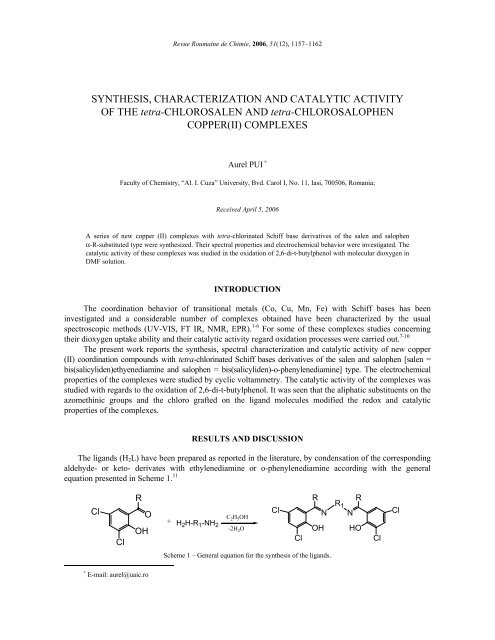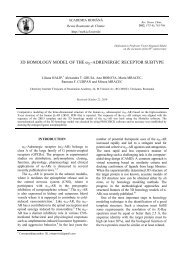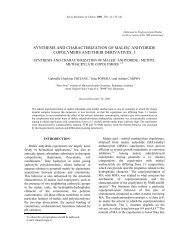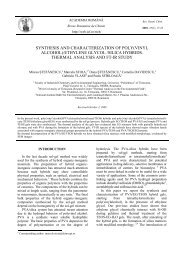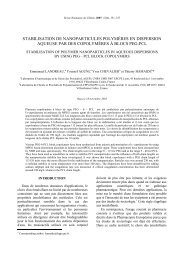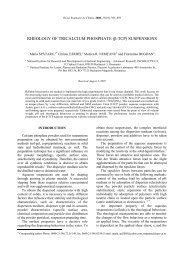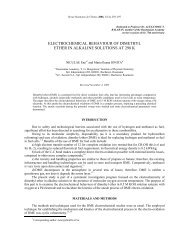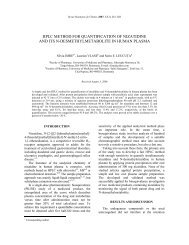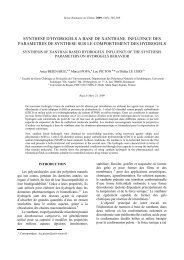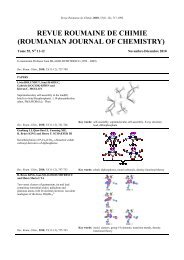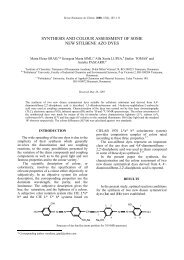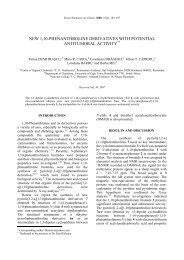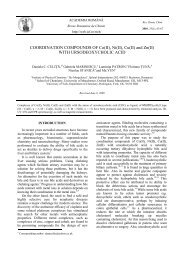SYNTHESIS, CHARACTERIZATION AND CATALYTIC ACTIVITY OF ...
SYNTHESIS, CHARACTERIZATION AND CATALYTIC ACTIVITY OF ...
SYNTHESIS, CHARACTERIZATION AND CATALYTIC ACTIVITY OF ...
Create successful ePaper yourself
Turn your PDF publications into a flip-book with our unique Google optimized e-Paper software.
Revue Roumaine de Chimie, 2006, 51(12), 1157–1162<br />
APERS<br />
<strong>SYNTHESIS</strong>, <strong>CHARACTERIZATION</strong> <strong>AND</strong> <strong>CATALYTIC</strong> <strong>ACTIVITY</strong><br />
<strong>OF</strong> THE tetra-CHLOROSALEN <strong>AND</strong> tetra-CHLOROSALOPHEN<br />
COPPER(II) COMPLEXES<br />
Aurel PUI ∗<br />
Faculty of Chemistry, “Al. I. Cuza” University, Bvd. Carol I, No. 11, Iasi, 700506, Romania;<br />
Received April 5, 2006<br />
A series of new copper (II) complexes with tetra-chlorinated Schiff base derivatives of the salen and salophen<br />
α-R-substituted type were synthesized. Their spectral properties and electrochemical behavior were investigated. The<br />
catalytic activity of these complexes was studied in the oxidation of 2,6-di-t-butylphenol with molecular dioxygen in<br />
DMF solution.<br />
INTRODUCTION<br />
The coordination behavior of transitional metals (Co, Cu, Mn, Fe) with Schiff bases has been<br />
investigated and a considerable number of complexes obtained have been characterized by the usual<br />
spectroscopic methods (UV-VIS, FT IR, NMR, EPR). 1-6 For some of these complexes studies concerning<br />
their dioxygen uptake ability and their catalytic activity regard oxidation processes were carried out. 7-10<br />
The present work reports the synthesis, spectral characterization and catalytic activity of new copper<br />
(II) coordination compounds with tetra-chlorinated Schiff bases derivatives of the salen and salophen [salen =<br />
bis(salicyliden)ethyenediamine and salophen = bis(salicyliden)-o-phenylenediamine] type. The electrochemical<br />
properties of the complexes were studied by cyclic voltammetry. The catalytic activity of the complexes was<br />
studied with regards to the oxidation of 2,6-di-t-butylphenol. It was seen that the aliphatic substituents on the<br />
azomethinic groups and the chloro grafted on the ligand molecules modified the redox and catalytic<br />
properties of the complexes.<br />
RESULTS <strong>AND</strong> DISCUSSION<br />
The ligands (H 2 L) have been prepared as reported in the literature, by condensation of the corresponding<br />
aldehyde- or keto- derivates with ethylenediamine or o-phenylenediamine according with the general<br />
equation presented in Scheme 1. 11<br />
Cl<br />
Cl<br />
R<br />
O<br />
OH<br />
+<br />
H 2 H-R 1 -NH 2<br />
C 2 H 5 OH<br />
-2H 2 O<br />
Cl<br />
Cl<br />
R<br />
N<br />
OH<br />
R 1<br />
R<br />
N<br />
HO<br />
Cl<br />
Cl<br />
Scheme 1 – General equation for the synthesis of the ligands.<br />
∗ E-mail: aurel@uaic.ro
1158 Aurel Pui<br />
Where:<br />
R 1 = - H 2 C-CH 2 -, (en) R 1 = o -C 6 H 4 -, (ophen)<br />
R = H, tetrachloro Salen, (tClSalen)<br />
R = H, tetrachloro Salophen, (tClSalophen)<br />
R = CH 3 , tetrachloro-dimethyl Salen,<br />
(tClMeSalen)<br />
R = CH 3 , tetrachloro-dimethyl Salophen,<br />
(tClMeSalophen)<br />
R = CH 3 CH 2 , tetrachloro-diethyl Salen,<br />
(tClEtSalen)<br />
R = CH 3 CH 2 , tetrachloro-diethyl Salophen,<br />
(tClEtSalophen)<br />
The ligands were characterized by elemental analysis, FT IR, UV-Vis and 1 H-NMR techniques. These<br />
analyses indicated that the target ligands had been obtained and good purity.<br />
The copper complexes have been prepared by reaction between Cu(OAc) 2 and the ligands, in a 1:1<br />
molar ratio, carried out in a water/ethanol solution according to the equation presented in Scheme 2. 12<br />
R<br />
R<br />
Cu(OAc) 2 + H 2 L<br />
H 2 O / Et-OH<br />
- 2 CH 3 COOH<br />
Cl<br />
O<br />
N<br />
R 1<br />
Cu<br />
N<br />
O<br />
Cl<br />
Scheme 2 – General equation for the synthesis of the cooper complexes.<br />
Cl<br />
Cl<br />
The complexes were characterized by elemental analyses, UV-VIS, FT IR and EPR spectroscopy. The<br />
elemental analyses indicate the formation of the complexes in a 1:1 molar ratio (CuL).<br />
Electronic spectra<br />
The UV-VIS spectra of the ligands and complexes were recorded in DMF due to the low solubility of<br />
the complexes in other organic solvents. The complexes spectra present modifications in the position and<br />
intensity of the bands characteristic to free ligands, as well as the apparition of new absorptions bands (Table 1).<br />
Table 1<br />
Electronic spectral data for the copper complexes in DMF<br />
Compounds<br />
λ 3 , nm (ε,<br />
l/mol·cm)<br />
λ 2 , nm (ε,<br />
l/mol·cm)<br />
λ 1 , nm (ε,<br />
l/mol·cm)<br />
Cu(tClSalen) 296 (3.98) 378 (4.02) 520 (2.78)<br />
Cu(tCldMeSalen) 298 (3.51) 376 (3.67) 525 (2.27)<br />
Cu(tCldEtSalen) 302 (3.65) 386 (3.57) 573 (2.03)<br />
Cu(tClSalophen) 312 (3.67) 422 (3.58) 550 (3.01)<br />
Cu(tCldMeSalophen) 340 (3.57) 450 (2.69) 566 (1.84)<br />
Cu(tCldEtSalophen) 326 (3.42) 424(3.51) 576 (2.18)<br />
The absorptions in 296-340 nm range and 370-450 nm range are assigned as π-π* or n-π* transitions.<br />
The absorptions from 370-450 nm range include intraligand bands overlapped with ligand-metal charge<br />
transfer, d-π* transition. The new bands appeared to the lowest energy absorption, in 520-570 nm range, can<br />
be assigned as d-d transition for Cu(II) in C 2v symmetry. 13,14 The results obtained from the electronic spectra<br />
are suggesting a square planar coordination geometry around the Cu(II).<br />
Infrared dpectra<br />
The FTIR spectra of the ligands show major bands around of 1600 cm -1 assigned to ν C=N , 1560 cm -1<br />
and 1500 cm -1 assigned to ring vibration, 1280 cm -1 assigned to OH phenolic deforming outside, 1230<br />
assigned to ν C-N , and at 1050 cm -1 assigned to ν C-O . The spectra of the complexes present, the C=N stretching<br />
mode is shifted to a lower frequency and additional shifts in the bands corresponding to C-N and C-O<br />
grouping compared with free ligands. Also, the characteristic ligands bands for the deforming outside the Ar-<br />
OH plan (around 1280 cm -1 ) are absent in the case of complexes, as a consequence of the involvement of the
Tetra-chlorosalophen and tetra-chlorosalophen copper(II) complexes 1159<br />
oxygen anion into a σ bond with the metallic centre. The formation of the metal-oxygen σ bond and metalnitrogen<br />
π-bond determines the apparition of new absorption bands in the region 420-685 cm -1 . 14,15 The<br />
principal FT IR absorption frequencies of the copper complexes are listed in Table 2.<br />
Table 2<br />
Significant IR absorbtion bands (cm -1 ) for the copper complexes<br />
Compounds<br />
ν C=N<br />
New bands<br />
Complexes Ligands ν M-O ν M-N<br />
Cu(tClSalen) 1624 1636 581 482<br />
Cu(tCldMeSalen) 1601 1611 551 472<br />
Cu(tCldEtSalen) 1587 1604 548 476<br />
Cu(tClSalophen) 1608 1617 536 457<br />
Cu(tCldMeSalophen) 1605 1648 556 474<br />
Cu(tCldEtSalophen) 1593 1645 552 490<br />
The FT IR spectra recorded support the formation of the complexes by the coordination of Cu to the<br />
azomethinic nitrogen and to the phenolic oxygen. 2,14<br />
Electrochemistry<br />
The electrochemistry of the complexes was investigated, as the redox potential is an important<br />
parameter in electron transfer processes in general and also in our catalytic systems. The studies of cyclic<br />
voltammetry show a quasi-reversible or irreversible behaviour for the more of complexes (Figure 1). The<br />
free ligands not show oxidation or reduction peaks in the investigated range.<br />
0.00006<br />
0.00004<br />
0.00002<br />
I (A)<br />
0.00000<br />
-0.00002<br />
-0.00004<br />
-1.4 -1.2 -1.0 -0.8 -0.6 -0.4 -0.2 0.0 0.2 0.4 0.6<br />
E (V)<br />
Fig. 1 – Cyclic voltmmogram of the Cu(tCldMeSalophen) complexes in DMF, v= 0.1V/s.<br />
The electrochemical data, the peaks values E pa , E pc , the difference from values E pa , E pc , ∆E, and semi-wave,<br />
E 1/2 potentials for the copper complexes are presented in Table 3.<br />
Examining the data collected in the Table 3 one can observe that the first two complexes and four and<br />
five have a quasi-reversible behavior, while the three and six present an irreversible behavior. This behavior<br />
may be explained by the steric hindrance in the complexes with the ethyl radicals.
1160 Aurel Pui<br />
#<br />
Table 3<br />
Electrochemical data for copper (II) complexes.<br />
Compounds # E pa E pc ∆E E 1/2<br />
Cu(tClSalen) -0.213 -0.736 0.523 -0.475<br />
Cu(tCldMeSalen) -0.151 -0.821 0.670 -0.486<br />
Cu(tCldEtSalen) -0.168 -1.229 1.061 -0.694<br />
Cu(tClSalophen) -0.115 -0.698 0.583 -0.406<br />
Cu(tCldMeSalophen) 0.029 -0.587 0.587 -0.279<br />
Cu(tCldEtSalophen) 0.303 -0.414 0.717 -0.055<br />
c [CuL] = 2x10 -3 M; scan rate 0.1 V/sec; E pa and E pc are the anodic and cathodic peaks potentials<br />
respectively. ∆E is E pa - E pc in 0.1M LiClO 4 in DMF. E 1/2 = (E pa +E pc )/2<br />
EPR Spectroscopy<br />
The EPR spectrum for the Cu(tCldMeSalen) in frozen DMF solution is presented in Figure 2. The<br />
spectrum consists of four clearly identifiable hyperfine lines splitting. These correspond to interaction of<br />
unpaired electron with the nuclear spin of copper from 64 Cu (I=3/2). The spectra exhibit a rhombic distortion<br />
from ideal axial symmetry, with their perpendicular branches split into two components, g 1 and g 2 , with the<br />
spin Hamiltonian parameters: g 1 = 2.213, g 2 = 2.056 and g 3 =2.053. The results indicate the occupancy of an<br />
unpaired electron in a “formal” d xy orbital. 14<br />
24000<br />
22000<br />
Intensity<br />
20000<br />
18000<br />
16000<br />
14000<br />
2400 2600 2800 3000 3200 3400 3600 3800 4000 4200<br />
Magnetic Field (G)<br />
Fig. 2 – EPR spectrum for Cu(tCldMeSalen) in frozen DMF solution at 100K.<br />
Catalytic activity<br />
The catalytic activity of the complexes has been studied in the oxidation reaction of the 2,6-di-tbutylphenol<br />
(DtBuP), with molecular oxygen, in DMF solution. The main products of oxidation reaction are<br />
quinone (QN) and diphenoquinone (DPQ) and the oxidation reaction is:<br />
OH<br />
O 2/ (ML)°<br />
O<br />
+<br />
O<br />
O<br />
O<br />
DtBuP QN DPQ
Tetra-chlorosalophen and tetra-chlorosalophen copper(II) complexes 1161<br />
The intensities and the peak’s area, available from both 1 H-NMR spectra and chromatograms, permit<br />
the evaluation of the transformation degree, and the quinone (QN) and diphenoquinone (DPQ) contents. The<br />
results obtained are listed in Table 4. Analysis of the evidence in the Table shows that for all the oxidation<br />
product is only DPQ. The yields are between 53% and 100%. This is in good correlation with redox potential<br />
and steric hindrance.<br />
Table 4<br />
Results of DtBuP oxidation with O 2 in presence of the Cu(II) complexes<br />
Compounds Yield % QN % DPQ %<br />
Cu(tClSalen) 99 100<br />
Cu(tCldMeSalen) 100 - 100<br />
Cu(tCldEtSalen) 94 - 100<br />
Cu(tClSalophen) 100 - 100<br />
Cu(tCldMeSalophen) 74 - 100<br />
Cu(tCldEtSalophen) 53 - 100<br />
The formation of the DPQ in high yield involves the reversible formation of some [CuL-O 2 ] adducts<br />
and CuL complexes are implicated in the stage of oxidation reaction, in formation of phenoxyl radicals. 16-18<br />
EXPERIMENTAL PART<br />
Elemental analysis (C, H, N) was performed by the Service de Microanalyses de Gif-sur-Yvette. 1 H-NMR spectra were<br />
recorded on a Brucker AM 250 or AC 250 spectrometers operating at 250 MHz. All spectra were obtained in CDCl 3 and chemical<br />
shifts calculated in ppm with respect to TMS (δ = 0) or solvent residual peak (δ = 7.26 for proton). UV-Vis spectra were taken on<br />
DES device, operating with the SAFAS program. The FT IR spectra were obtained on a Bruker IFS 66 apparatus in KBr pellets. EPR<br />
spectra were recorded in frozen DMF solution at 100K, on a Brucker Elexis apparatus.<br />
Cyclic voltammetry experiments were performed on an Autlab apparatus. The recordings were made in a 2mM solution in<br />
DMF under argon atmosphere, using lithium perchlorate as electrolyte support. The following material has been used for analysis: as<br />
working electrode a vitreous carbon electrode (A = 4.0 mm 2 ); as reference electrode, a saturated calomel electrode and as auxiliary<br />
electrode a platinum wire.<br />
The catalytic activity was studies followed the oxidation of 2,6 di-tert-butyl phenol (DtBuP) with molecular oxygen, on<br />
employing the synthesized compound as catalysts. The reaction products have been separated by elution on a silica column with<br />
CH 2 Cl 2 -C 7 H 16 (1/1) as eluent. The analysis of the oxidation products has effected by 1 H-NMR and by gas-chromatography on a<br />
Bruker AM 250 and Fison 9000 GLC apparatus, respectively. The reagents used were obtained from Acros or Aldrich and used<br />
without further purification.<br />
3,5-dichloro-2-hydroxybenzaldehyde and 3,5-dichloro-2-hydroxyacetophenone are commercially available. The 3,5-dichloro-<br />
2-hydroxyacetophenone and 3,5-dichloro-2-hydroxypropiophenone have been obtained by Friedel-Crafts substitution of the<br />
corresponding dichlorophenols, with acetyl- and propionyl chloride, respectively. The salen type ligands and tClSalophen have been<br />
prepared by heating a solution of 2 eq. carbonyl derivative and 1 eq. diamine in MeOH at 40 °C.<br />
For the preparation of the other ligands, tCldMeSalophen and tCldEt-Salophen, the reactions was carried out by the same<br />
procedure, but at cold (5-10 °C and 0-5 °C respectively). Since the products were impure (mono- and bis-imines) and coupling yields<br />
low, the method described by Boghaei and Mohebi has been used. 19 The reaction of the carbonyl derivative and o-phenylenediamine<br />
in a 1:1 molar ratio yielded the unsymmetrical monosubstituted amine, which was separated and reacted further with another<br />
equivalent of carbonyl, to give the desired ligand with fair yields.<br />
The Cu(II) complexes were synthesized by general methods. 20 To a solution of 1 equivalent of ligand dissolved in methanol or<br />
ethanol (25 mL) was added Cu(OAc) 2·6H 2 O (1 equivalent) dissolved in water (5 mL) at 40 °C, with stirring. A precipitate was<br />
deposited immediately. The mixture is further stirred at 40°C for one hour. After cooling to room temperature, the solid is filtered<br />
and washed successively with water, ethanol-water mixture and absolute ethanol. After drying in vacuo, the copper complex is<br />
isolated and analyzed.<br />
The catalytic activity was investigated in the oxidation of 2,6-di-tert-butyl-phenol with molecular oxygen, in the presence of<br />
catalytic amounts of complex. The reaction is performed in a 100 mL round-bottomed flask sealed with a rubber septum, at room<br />
temperature. The flask is connected via a syringe needle to a gas burette. General catalytic procedure: complex (2.5x10 -2 mmols,<br />
5% molar to substrate) are dissolved in dry degassed DMF (5 mL) under argon, and of DtBuP (103 mg, 0.5 mmols) dissolved in<br />
DMF (5 mL) was added. The argon is evacuated under vacuum and the flask is refilled with oxygen and connected to the burette.<br />
The stirring is started, with monitoring of the oxygen consumption. After 24 h, the reaction is stopped and the mixture is separated by<br />
flash chromatography eluting with dichloromethane-heptane 1:1 (v:v). After evaporation of volatiles, the fractions are analyzed by<br />
NMR and GC, determining conversion and yields of products.<br />
CONCLUSIONS<br />
Grafting of various substituents on the aromatic ring and in the azomethinic group of Salen and<br />
Salophen type ligands, lead to the obtaining of some new ligands. In reaction with Cu(II) ions, they form
1162 Aurel Pui<br />
coordinative compounds with square planar geometry. Such compounds are of interest in oxygen reversible<br />
fixation and catalytic activity.<br />
REFERENCES<br />
1. P. A. Vigato, and S. Tamburinii, Coord. Chem. Rev., 2004, 248, 1717-2128.<br />
2. T. Xishi, Y. Xianhong, C. Quian and T. Minyu, Molecules, 2003, 8, 439-443.<br />
3. P. Alessandro, B. Elisa and S. Mauro, Polyhedron, 1996, 15, 4461-4467.<br />
4. L. C. Nathan, J. E. Koehne, J. M. Gilmore, K. A Hannibal, W. E. Dewhirst and T. D. Mai, Polyhedron, 2003, 22, 887-894.<br />
5. X. R Bu, C. R. Jackson, D. Van Derveer, X. Z. Uou, Q. J Meng, and R. X. Wang, Polyhedron, 1997, 16, 2991-3001.<br />
6. S. S. Djebar, B. O.Benali, and J. P. Deloume, Polyhedron, 1997, 16, 2175-2182.<br />
7. Y. Wang, L. DuBois, B. Hedman, K. Hodgson and T. D. P. Stack, Science, 1998, 279, 537-540.<br />
8. L. I. Simàndi, “Dioxygen Activation and Homogeneous Catalytic Oxydation”, Elsevier: Amsterdam, 1991, p.279-284.<br />
9. K. Selmeczi, M. Réglier, M. Giorgi and G. Speiser, Coor. Chem. Rev., 2003, 245, 191-201.<br />
10. L. I. Simándi, T. M. Simándi, Z. May and G. Besenyei, Coord. Chem. Rev., 2003, 245 (1-2), 85-93.<br />
11. Al. Cascaval and Gh. Z. Stoica, (19) Ro (11) Pat. 105122, 1995.<br />
12. B. Jani and P. K. Bhattacharya, Ind. J. Chem., 1977, 15A, 750-753.<br />
13. A. B. P. Lever, “Inorganic Electronic Spectroscopy”, 2 nd Edition; Elsevier, London, 1992, p.554-572.<br />
14. E. Suresh, M. M. Bhadbhade, and D. Srinivas, Polyhedron, 1996, 15, 4133-4144.<br />
15. K. Nakamoto, “Infrared and Raman Spectra of Inorganic and Coordination Compounds”, part B, 5 th Edition; John Wiley &<br />
Sons, Inc.: New York, 1997, p. 157-160.<br />
16. M. F. Rio, D. Pujol, C. B. Chateron, M. P. Fauvet and A. Gaudmer, J. Chem. Soc. Perkin Trans. I, 1984, 1971-1979.<br />
17. Y. Deng and D. H. Busch, Inorg. Chem., 1995, 34, 6380-6386.<br />
18. D. A. Rockcliffe and A. E. Martell, Mol. Catalysis A: Chem., 1996, J. 106, 211-221.<br />
19. D. M. Boghaei and S. Mohebi, Tetrahedron, 2002, 58, 5357-5366.<br />
20. R. H. Bailles and M. Calvin, J. Am. Chem. Soc., 1947, 69, 1886-1889.


